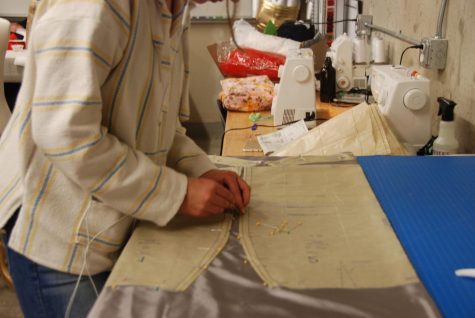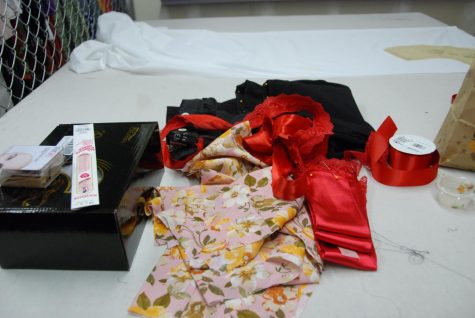The costumes cages, located underneath the stage in the Performing Arts Center, contain a wealth of every possible article of clothing.
Pinning, tapering, and fitting: A day in the life of a costumer
When I descended the stairs on stage left into what is known within the theater program as, “The Cages,” I was immediately met with racks upon racks of costumes. They were labeled with signs like, “Women’s wear—bridal dresses, formal dresses, and historical,” and spanned various colors, age groups, and decades. Walking in, I essentially felt like I was entering a world where Alice in Wonderland met Downton Abbey met early 2000s-Disney Channel outfits.
With just four days left before tech week, and fifteen before opening night, each member of the costumes crew knew their responsibilities and was deep in work on their final pieces. The space was filled with girls pulling costumes off racks and labeling them, pinning fabric to cut dresses, and ironing dresses.
When someone brought downstairs the news that “actors are ready for fittings,” Cassandra Murray turned to me and calmly said, “this is when costumes gets stressful.” We ventured upstairs and through a door labeled “hair and makeup,” which contains both the women’s and men’s dressing rooms. Then, members of the costumes crew called in their actors. Some had to try on multiple costumes, shoes, and accessories, while others just needed to put on their shirt or suit jacket, and the members of the crew then made sure everything laid and fit well. If it did not, they took new measurements and occasionally a seam ripper to the material.

Members of the crew pin “pattern pieces” to fabric, which will allow them to neatly cut out what they need to sew a dress.
Before they ever got to planning costumes, though, the crew spent weeks researching the time period the play is set in. They began learning about the architecture, the makeup, the home trends, and of course the clothing, and also read the script together. Once they were assigned their characters, each individual on the crew did more specific research. A few weeks ago, the crew took a trip to the thrift store and began combing through the racks below the Performing Arts Center. Those who did not find pre-made items they could use began constructing their own.
As Eva Jones explained to me, the crew members put in requests for their characters at the beginning of production. Ultimately, Rebecca Stafford, the adult who coordinates much of the props and costumes portions of the show, and Lacea Weakland, costumes lead, made final decisions about who worked on what. When I asked about the number of costumes in the show, the crew’s consensus was that each actor needed an average of two to three. With eleven roles, and an additional fifteen parts being played by five members of the ensemble, the number turned out to be nearly thirty. Avery Sanchez explained that the number of costumes that a show requires depends primarily on its number of scenes, adding, “For Rent, my character had three or four costumes, but for this show, my character has one.”
Jones also talked about what it takes to join the costumes realm. She expressed that she has been sewing a long time, having made her own Halloween costumes in the past and also having taken Fossil Ridge High School’s fashion class. However, despite her extensive knowledge of costume construction, she had no prior experience in the nuance changes that a play requires, such as hemming dresses or tapering pants. Additionally, she learned about how to take proper measurements.
After each girl returned from fitting their actor, the crew sat down with Spafford to discuss what they still need. Because all costumes have to be completely ready for the dress rehearsals that begin next week, all final costume pieces had to be ordered by the next day, and Spafford described these last few days as “crunch time.” Most members of the crew needed small final items, like white cat-eye glasses or kitten heels.

Besides the traditional shirt, pants, and jackets a costume requires, the crew is also responsible for finding accessories that help craft the characters.
Then, the conversation turned to the costume budget. The crew uses a combination of items found in the cages, at thrift stores, and online to create the show, and they have to track each payment to ensure they spend only the amount of money they can afford. As Spafford put it, though, “I will go down to every last penny of a budget. That’s why we have it.” As each girl began combing through receipts and order histories, the mood in the room grew noticeably more stressed, and I began to hear, “I’ve only spent $57” and “I’m over budget. By seven dollars.”
The rest of the week will consist of final costume preparation and fittings. The beginning of tech week will bring the first dress rehearsals; the costumes crew will shift their focus to troubleshooting costume problems as they arise onstage. Some members of the crew will also be responsible for helping with quick changes in the dressing rooms during the show. During tech week, each crew will bring what they have been working on together, so check back in to this series for hourly updates on how these final workdays unfold.

